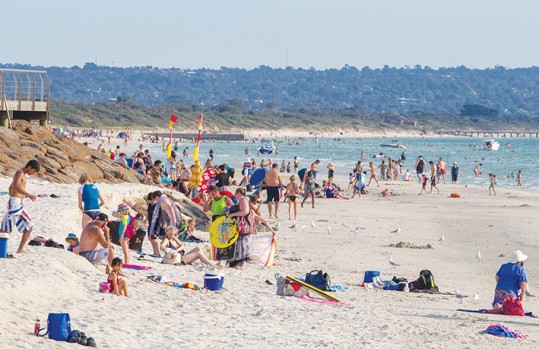
DESPITE “ticking all the boxes” for being in a location where people are most likely to drown – near beaches, rivers, pools and boating areas – Carrum Surf Life Saving Club has, touch wood, been spared the drama this year.
And it has all the more reason to be satisfied because the Patterson River mouth is regarded as one of the busiest recreational boating zones in the southern hemisphere.
With a sandbar across its mouth, it is now especially rough as it enters Port Phillip Bay. “Boats power into the river and then come to an immediate stop,” club secretary Ben Rooks said. “Life jackets are compulsory for all boat users and that’s good because they act a bit like seat belts in cars.”
He was commenting on Life Saving Victoria’s 2013-14 Victorian Drowning Report, which reveals that 47 people drowned in Victoria in the past year. That’s an increase of six over the previous year and the highest drowning toll the 10 years 2003-2013.
The report was launched by Parliamentary Secretary for Police and Emergency Services David Southwick MP and Life Saving Victoria president Tom Mollenkopf last week.
The Melbourne region had 23 drowning deaths – up four on the 10 year average. Of those, one occurred at a City of Bayside beach, which is consistent with the 10 year average.
Mr Rooks said drowning victims were often males affected by alcohol, prompting the Kingston Council to declare the lifesaving club precinct an alcohol-free zone. It continues to be a key risk factor, with 12 drowning deaths in the year, compared to an average of nine in 2003–2013.
“They think they can perform to the best of their abilities when affected by alcohol, but, of course, they can’t,” he said.
A key finding of the Drowning Report was that unintentional water entry – slips/trips/falls – accounted for more than a third (17, 36 per cent) of fatal drowning incidents. This is similar to the past decade which had 39 per cent unintentional water entry drownings in 2003–2013.
Drowning in inland waterways increased dramatically to 22 this year after decreasing last year. This is up 62 per cent on the 10 year average.
Drownings in the 15-24 year age group rose 52 per cent. The number among those aged over 60 has risen 49 per cent.
Males continue to be over-represented with 79 per cent (37) of all drowning deaths. The drowning rate (per 100,000 people) has increased by 13 per cent over the previous 10 years.
Report author Dr Bernadette Matthews said the high number of drownings of people who didn’t even intend to be in the water is alarming. “More than a third (17, 36 per cent) were the result of slips, trips and falls,” she said.
“This has been a consistent trend over the past decade and highlights the need for us to make a change to become more aware and prepared, with improved swimming skills and water safety knowledge, so that we have a greater chance of survival if we do get into trouble.”
She said people who have been drinking either make poor decisions about entering water – such as trying to swim across a river, perhaps clothed, or late at night – or have unintentionally entered the water, having slipped or fallen.
“People need to stop thinking ‘It will never happen to me’ and realise that alcohol affects everyone’s abilities in the water, even the strongest of swimmers. Alcohol not only affects our judgement but also our ability to respond in the water should we fall in.”
Drownings among two key age groups (those 15–24 and 60 and over) have risen 50 per cent, Dr Matthews said. “Older people are reminded to check their skills, health and fitness before swimming, boating, fishing and kayaking, and be extra careful of slips and falls around water,” she said.
Beachgoers should be aware of how dangerous beaches are and how quickly conditions can change – even on ‘nice’ beach days.
“All reported coastal drowning deaths occurred at beaches that were not patrolled by lifesavers at the time,” said Dr Matthews.
“People need to be aware of the dangers and be prepared by checking the weather and conditions and reading safety signs to understand the hazards before entering the water.
Mr Rook said Carrum lifesavers began their summer patrols last weekend and would continue throughout summer. “Always swim between the flags,” he said.